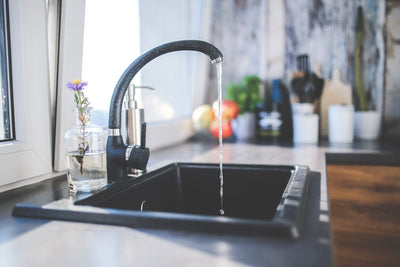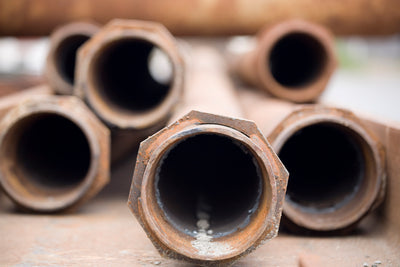Eric Roy, Ph.D. | Scientific Founder
***Updated to include 2021 water quality data***
For Hydroviv’s assessment of Washington, D.C. drinking water, we aggregated water quality test data from D.C. Water (the public utility provider) and the U.S. Environmental Protection Agency (EPA), as well as from samples that we collect and analyze. We cross reference these data with toxicity studies in the scientific and medical literature, and look at upcoming regulatory changes. The custom water filters that build and sell for Washington, D.C. are optimized with these factors in mind.
Lead In DC Tap Water
Washington, D.C. is an old city with a lot of lead service lines, so it's not a huge surprise that D.C. has had such a big problem with lead in drinking water. Lead leaches from lead-containing pipes, solder, and fittings, unlike most contaminants which are found at the source. D.C. Water uses two sampling periods when testing for lead: January-June and July-December. In the 107 samples pulled during January-June period, the 90th percentile concentration for lead was 2 parts per billion, and 3 samples were above the 15 part per billion Action Level (AL). In the 105 samples pulled from the July-December sampling period, the 90th percentile concentration was 3 parts per billion, and one of the collected samples exceeded the action level. Although these results indicate that D.C. is in citywide compliance with federal water quality standards, it's important to point out that EPA, CDC and the American Academy of Pediatrics all agree that there is no safe level of lead for children. The bottom line is that the federal standards allow up to 10% of sampled taps to have lead concentrations over 15 parts per billion.
We highly recommend that Washington D.C. residents take a look at this map to see if their home has a lead service line, because those homes (and homes with plumbing that predates 1986) are most susceptible. We also highly recommend taking advantage of D.C. Water's free lead testing program, and any families with small children take steps to remove any lead from their water, even if they don't use a Hydroviv filter. It's important to remember that most pitchers and fridge filters do NOT remove lead from water. Hydroviv Undersink filters are NSF/ANSI 53 certified to remove lead from drinking water.
Detectable Levels of Unregulated Contaminants In DC Tap Water
One thing that has caused quite a bit of alarm from several people in this year's report is that several herbicides, VOC's and synthetic compounds were all found at detectable levels in D.C. drinking water. Herbicides such as Dalapon, shouldn't be a huge surprise seeing that D.C. draws water from near at the end of a river, so there is opportunity for agricultural runoff to enter the river. For anyone who is interested, The Maryland DEP has made the Source Water Assessment for the Potomac River (404 pages) publicly available.
DC's Water Source: Potomac River
The Washington Aqueduct (operated by the Army Corps of Engineers) draws water from the Potomac River for treatment. District of Columbia Sewer and Water Authority (aka D.C. Water) purchases treated water from the Washington Aqueduct, and is responsible for distributing it throughout D.C. We also have a stand-alone article that entirely focuses on the Potomac River.
Left Out Of The Report: Chromium 6
We were a bit surprised to see Chromium 6 left out of the 2019 water quality report for Washington, D.C. Even though it's a known human carcinogen, chromium 6 is categorized as an "Emerging Contaminant" by EPA but is not regulated on its own. D.C. Water (and 6000 other municipalities) participate in the Unregulated Contaminant Monitoring Rule (UCMR3), which is a nationwide testing program to study "emerging" contaminants. UCMR acknowledges that contaminants on the list most likely cause adverse health effects, including cancer. The concentration in D.C. water average 86 parts per trillion. For perspective, these levels are roughly 4-5x higher than what The State Of California set as a public health goal. We believe that people should not wait for EPA to begin regulating chromium 6 on its own, and filter their water, even it they aren't using our product. It's important to remember that most pitchers and fridge filters do NOT remove chromium 6 from water.
Per and Polyfluoralkyl Substances (PFAS) In Washington, D.C. Drinking Water
PFAS are a category of chemicals found in various non-stick/stain resistant products, as well as fire fighting foam. PFAS are considered to be "emerging contaminants" because they are not currently regulated by EPA, but are known to be toxic and persistent in the environment. PFAS have been detected at surrounding military installments that are in close proximity to the Potomac River (DC's source water). Most municipalities are not required to test for, or remove, PFAS from drinking water. Not all filters are designed to remove PFAS from drinking water. If you'd like find water filters that remove PFAS from tap water, check out this Duke/NC State study.
Disinfectant
The primary disinfectant used to treat Washington DC's tap water is chloramine, except for a few weeks in the spring when DC switches over to chlorine. D.C. (and a growing number of municipalities) use chloramine instead of chlorine for a few reasons: for one, chloramine is more persistent than chlorine, so it maintains its ability to disinfect the water further away from the source. On the other side, chloramine does not quickly dissipate from water if left in a jug overnight. If you want to get it out of the water, you'll need a filter designed to remove chloramine, because a regular charcoal filter doesn't do a great job removing it.
If you want to learn more about Hydroviv's water filters, check out www.hydroviv.com, or drop us a line through live chat or email (hello@hydroviv.com). Even though we sell our products nationwide, Hydroviv is a DC company and we take care of our own backyard!
As always, feel free to take advantage of our "Help No Matter What" approach to technical support. We will answer your questions about water quality even if you have no desire to purchase one of our products.
Other Articles We Think You'll Enjoy:
Please Stop Using a TDS Meter To Evaluate Your Home's Water QualityThings To Know Before Replacing Your Home's Lead Service Line
How To Filter Chromium 6 From Drinking Water







